REaCH
Overview
REaCH is an advanced IoT-based system designed to improve safety for first responders during hazardous incidents. It captures and displays health and environmental data in real-time, enabling incident commanders to make timely decisions.
As a Product Manager, I led a team to develop a wearable IoT sensor and dashboard to address the serious issue of firefighter safety. The product development was conducted in three phases - ideation, MVP development, and product launch, focusing on user feedback, test results, and strategic marketing approaches.
The goal of REaCH is to reduce on-duty injuries and improve response times. The project's success will be measured by these metrics along with the product's adoption rate by other fire departments. The journey has been both challenging and rewarding, with the potential to have a profound impact on first responders' safety.
My contribution
Product Strategy User Research Scrum Master Quality Assurance Full-Stack Development support Deployment Management GTM Strategy
The team
1 × Director 1 × Product Manager/Scrum Master 1 × Technical Consultant 4 × Full Stack Developer 1 × Product Designer 1 × Subject-Matter Expert Consultant 3 × Professor
Year
2020
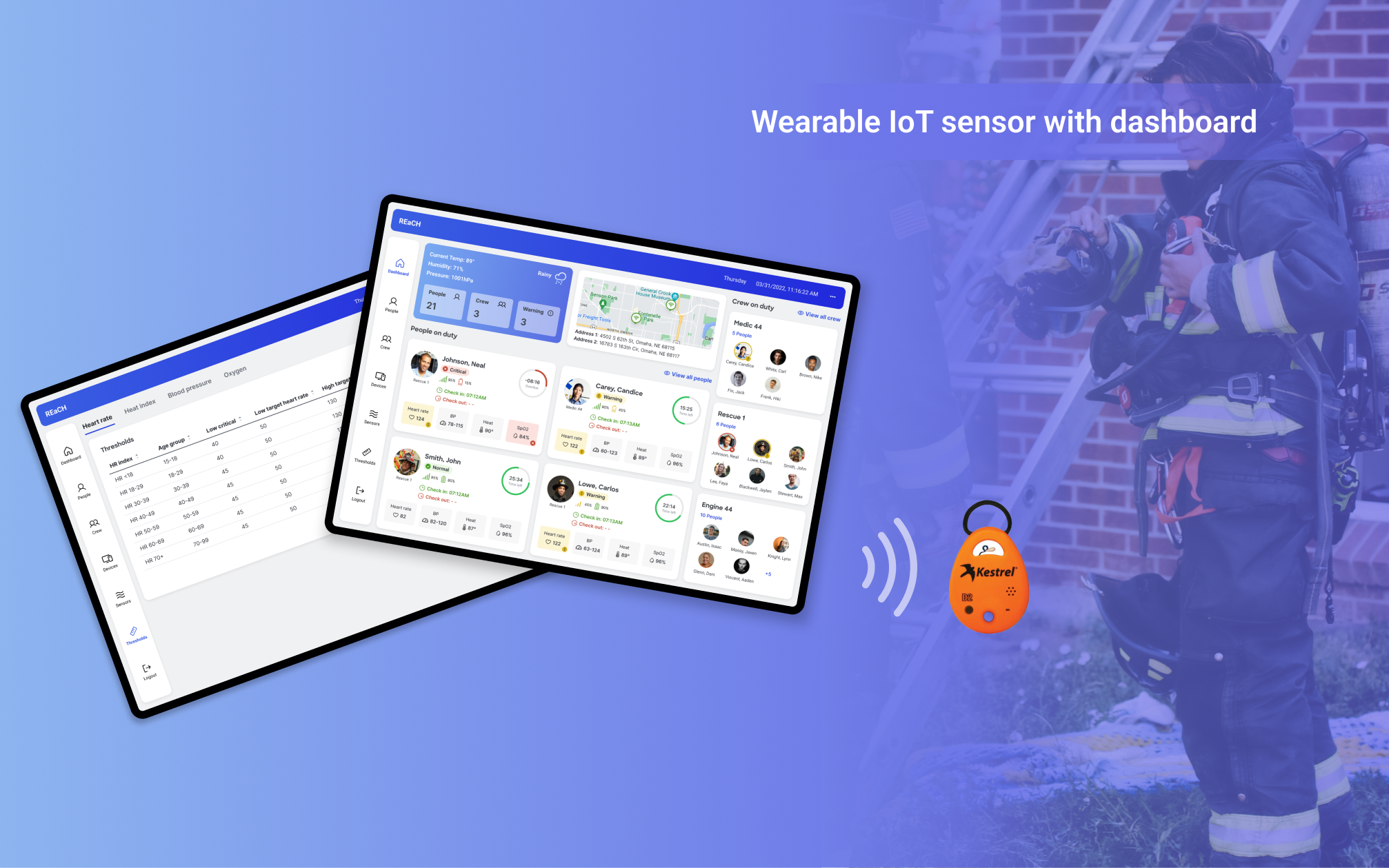
Problem Statement
Our first responders, including firefighters, confront grave risks daily, often facing hazardous environments while saving lives. Statistically, over 100 on-duty firefighter deaths occur annually in the US, along with more than 28,000 health-related incidents over the past decade. Unfortunately, the existing safety solutions are primarily designed for communication purposes and do not cater to real-time health and environmental monitoring, creating a significant safety gap.
Additionally, during high-stress HAZMAT incidents, first responders may struggle to accurately self-assess their health status. This lack of real-time health data can escalate health risks, leading to severe complications or even loss of life.
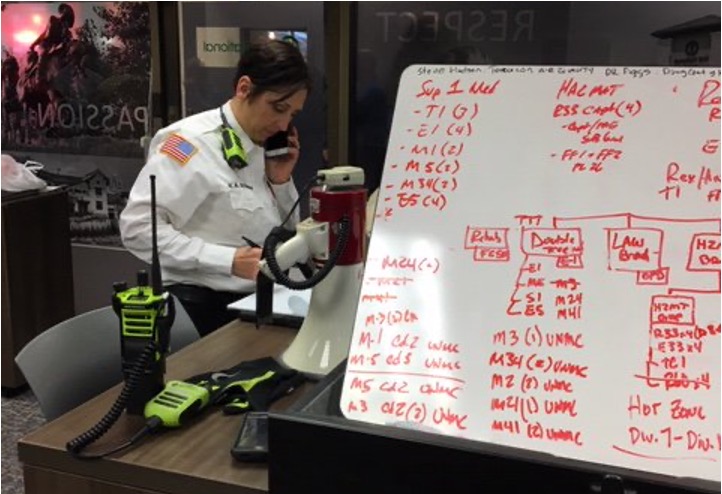
Therefore, the problem at hand is the need for an advanced safety solution that monitors and provides real-time data on the health status and environmental exposure of first responders during hazardous incidents. Such a system would significantly improve safety measures, potentially preventing injuries and saving lives.
I have taken 3 phases approach – ideation, MVP development, product execution launch.
Ideation & User Research
Phase 1 - Researched how the problem was solved today, any alternative solutions, Conduct interviews, surveys, observations based on each key personas to understand pain points, user journey and brainstorm for solutions.
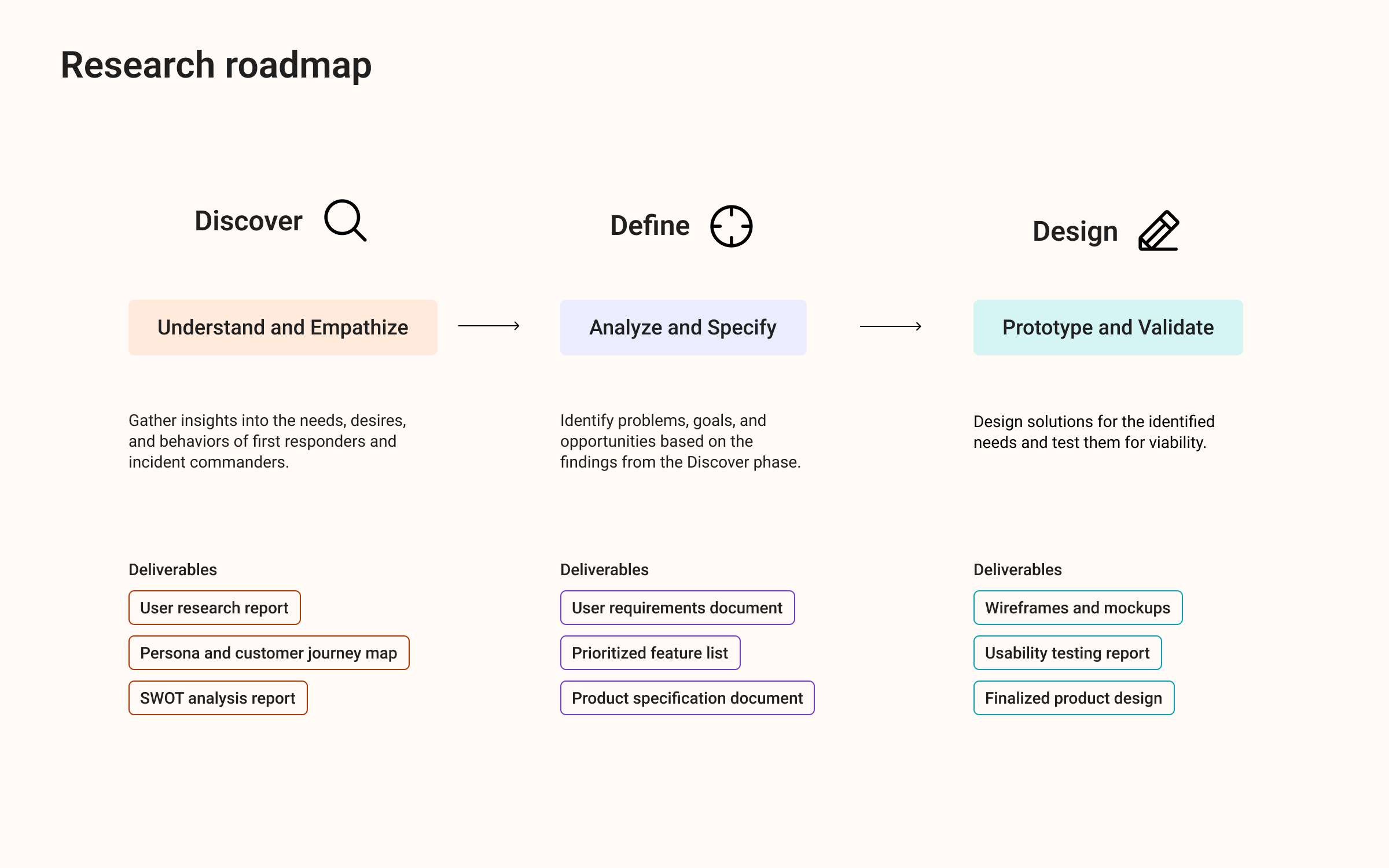
Each of these phases should be iterative, meaning that you may need to go back and forth between them based on your findings. Also, the user should be involved throughout the process to ensure the product aligns with their needs and expectations.
Research Methodology
Our user research methodology was comprehensive, focusing on understanding the unique needs and challenges faced by first responders, particularly firefighters, during HAZMAT incidents.
Interviews:
We conducted in-depth interviews with 40 first responders, including firefighters and incident commanders. Discussions were centered around their experiences during HAZMAT incidents, their safety concerns, and the perceived effectiveness of existing safety measures.
Surveys:
To gain broader insights, we disseminated online surveys to over 150 first responders across different states. The survey focused on understanding the frequency of health-related incidents during their duties, their biggest safety concerns, and their suggestions for improving safety measures.
Observations:
Our team attended 3 training drills and live incidents to get a firsthand understanding of the challenges faced by first responders. This provided invaluable insights into the physical and psychological stressors faced during incidents.
Persona Development:
Using the collected data, we developed three user personas representing our key user groups: frontline firefighters, incident commanders, and emergency medical personnel, The Technical Support Staff, Administrator. These personas served as guiding frameworks for our product design and feature development.
Feedback Loops:
After developing the MVP, we engaged with 22 early adopters across the City of Omaha fire departments. Their continuous feedback proved vital in improving and refining the product to ensure it provides maximum value.
Through this comprehensive user research, we garnered crucial insights that helped us design the REaCH system to cater specifically to the needs of first responders during HAZMAT incidents.
Persona Development
Our comprehensive user research allowed us to develop distinct user personas, each representing unique user groups with their own needs, pain points, and usage behavior.
Frontline Firefighters:
This includes the first responders, primarily firefighters, who are directly engaged in managing the HAZMAT incidents. They are the primary users of the wearable IoT sensors and a critical group for product feedback.
Incident Commanders:
These are the officials who oversee and manage the HAZMAT incidents. They use the REaCH system to monitor the health parameters of the on-ground team in real-time and make informed decisions.
Emergency Medical Personnel:
This consists of medical professionals who provide immediate care to the first responders in case of health complications. They utilize the health data provided by the REaCH system to take preemptive actions and provide required medical interventions.
Technical Support Staff:
These are the support personnel who ensure the smooth operation of the IoT sensors and the REaCH system. Their feedback on system performance and functionality can help in continuous product improvement.
Administrative Decision-Makers:
This segment includes the decision-makers within the firefighting and emergency response departments who are involved in the adoption and purchase decisions of such systems. Demonstrating the value and benefits of the REaCH system to this group is critical for market penetration and expansion.
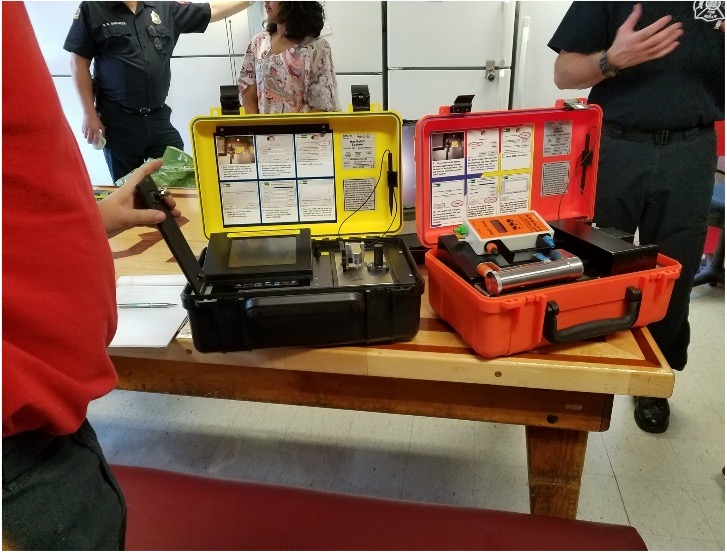
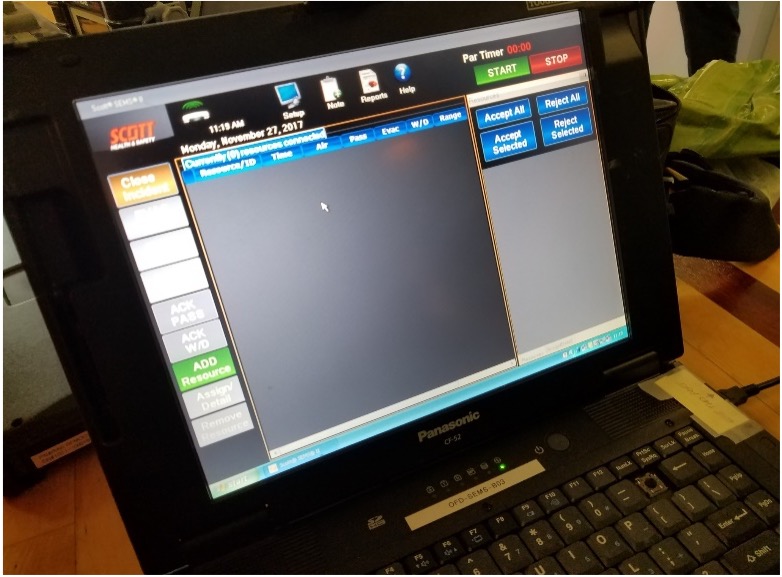
By understanding the distinct needs of these segments, we can design and develop features that specifically cater to each group and effectively communicate the product benefits to the potential buyers.
Key Personas
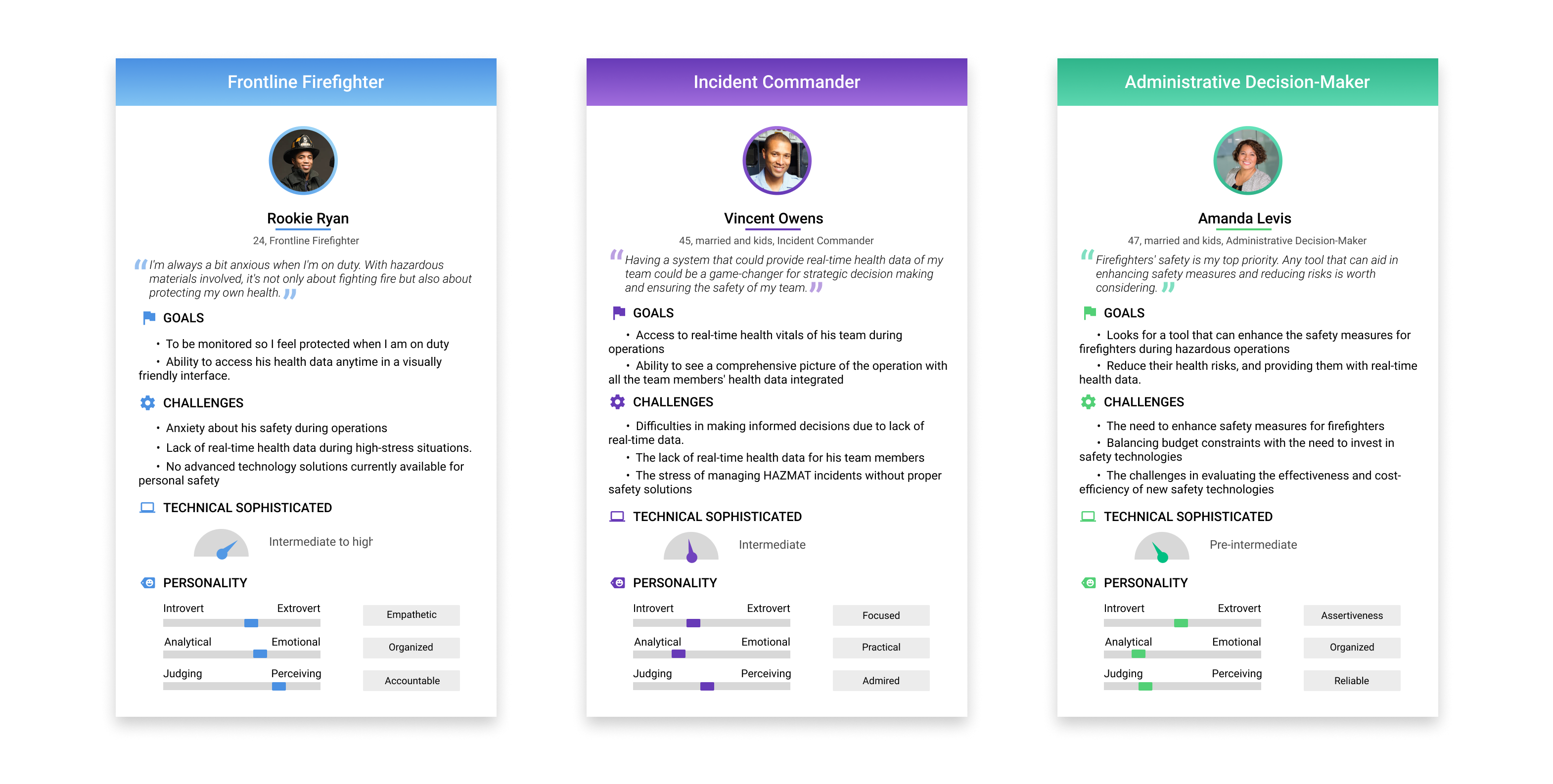
MVP & Features
Phase 2 - Developed MVP to track health and environmental data and displayed it on a dashboard with alert notifications. Prioritized features based on feedback from stakeholders through each sprint and tested in 22 fire stations in local omaha. Proven to be effective solution for City of Omaha fire department.
Key Product specs
User Stories & Acceptance Criteria
Hazmat First Responder:
As a Hazmat First Responder, I want my health vitals to be monitored from the moment I begin responding to an event, so that I can ensure my personal safety and the effectiveness of my response.
- The system shall initiate monitoring of my health vitals the instant I start responding to an event.
- The system should provide real-time data regarding my health vitals on a tablet or smartphone-based dashboard, offering immediate feedback during the event.
- The system must have pre-set threshold values for each vital. If a vital reading crosses its threshold value, the system should alert me and/or the designated health monitoring team to take necessary action.
As a Hazmat First Responder, I want to have 24/7 access to my health data in a visually friendly interface, so that I can gain insights into my health condition during incidents and understand their potential impact on my long-term health.
- The system shall provide a user-friendly interface for accessing my health data at any time.
- The system should generate reports based on my health data, offering insights and suggestions to help me maintain my health while performing my duties.
- The report generation feature should allow for customization, enabling me to view my data in daily, weekly, or monthly intervals.
As a Hazmat First Responder, I want my equipment status to be monitored and displayed on the dashboard, so I can ensure that it's working properly and safely.
- The REaCH system shall continuously monitor and display the status of my equipment on the user dashboard.
- The system shall send an alert when any equipment malfunction or irregularity is detected.
- Reliability: The system should be reliable 99.99% of the time with the maximum time to fix any issue being 24 hours.
Incident Commander:
As an Incident Commander, I want access to real-time data from the moment first responders start responding to an event, so that I can manage the situation efficiently and ensure the safety of my team.
- The system shall initiate the display of real-time data on a tablet or smartphone-based dashboard as soon as a first responder starts responding to an event.
- The dashboard should provide an overview of each first responder’s health vitals and equipment status.
- The system should alert me if any vital reading crosses its threshold value, or there's an equipment malfunction, allowing me to take necessary action.
As an Incident Commander, I want to have 24/7 access to the health data of my team in a visually friendly interface, so that I can strategize and plan for future incidents based on past data.
- The system shall provide a user-friendly interface for accessing the health data of the team at any time.
- The system should generate reports based on the health data and equipment status, providing insights to help strategize and plan for future incidents.
- The report generation feature should allow for customization, enabling me to view the data in daily, weekly, or monthly intervals.
As an Incident Commander, I want alerts for any critical health or equipment issues, so I can swiftly deploy assistance or resources where needed.
- The REaCH system should send immediate alerts for any critical health or equipment issues.
- The alerts should provide sufficient detail to allow me to determine the urgency and type of assistance required.
- Reliability: The system should be reliable 99.99% of the time with the maximum time to fix any issue being 24 hours.
Performance: The system should deliver on response time, accuracy, system uptime, and data security.
System Design & Architecture
We integrated the Kestrel DROP wireless sensor to collect environmental data to monitor the Ambient Heat Index and Polar H10 to collect heart rate from the sensors placed inside the First Responder’s PPE suit. The sensors implement a Bluetooth Low Energy communication protocol which is a low-power wireless communication technology. The REaCH system must be able to establish connectivity and reliably stream live, accurate data from the sensor smoothly to achieve the goal of the research.
Refer Figure 1 for IoT communication architecture implemented for smooth and reliable real-time data streaming from the sensors:
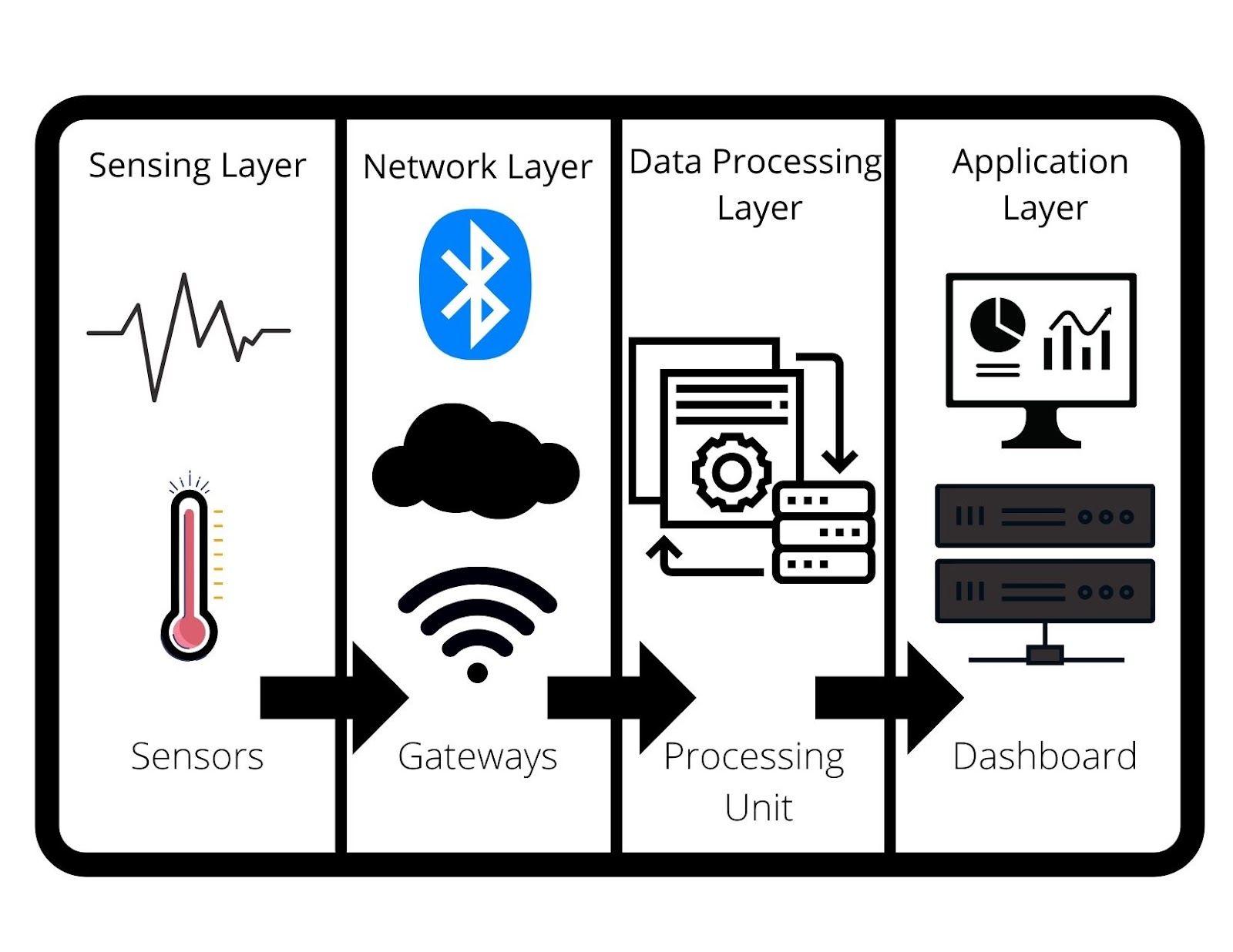
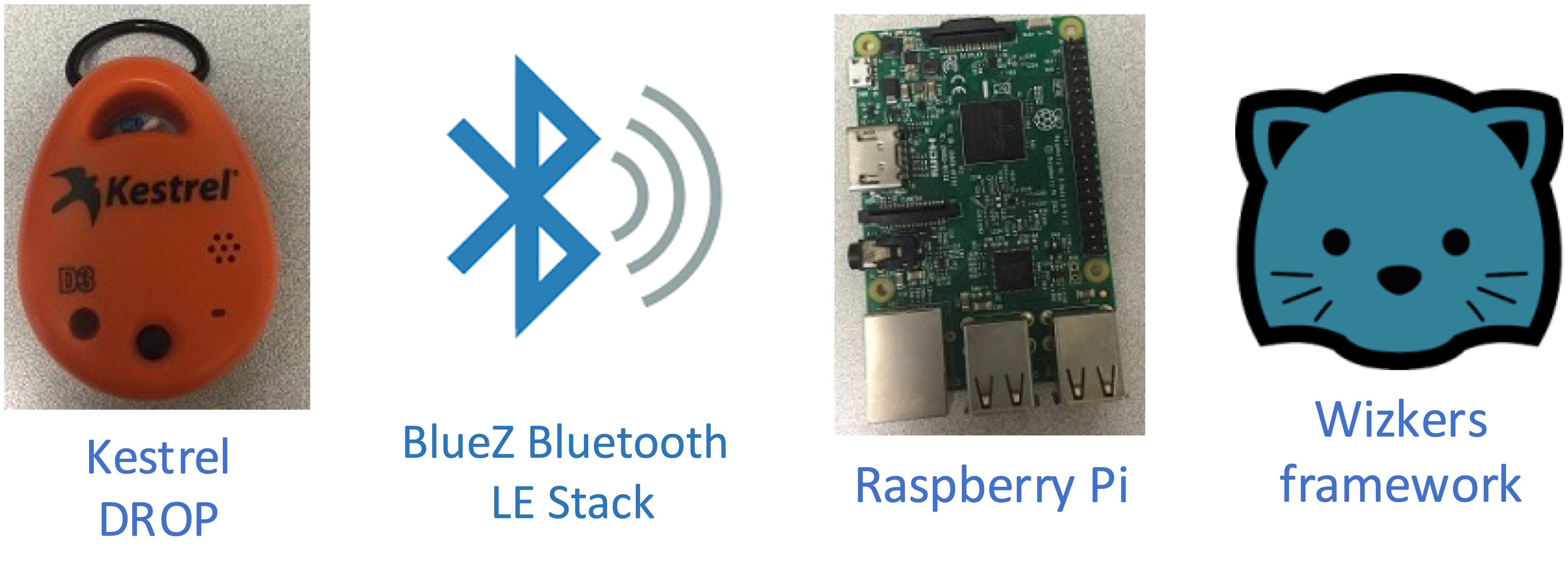
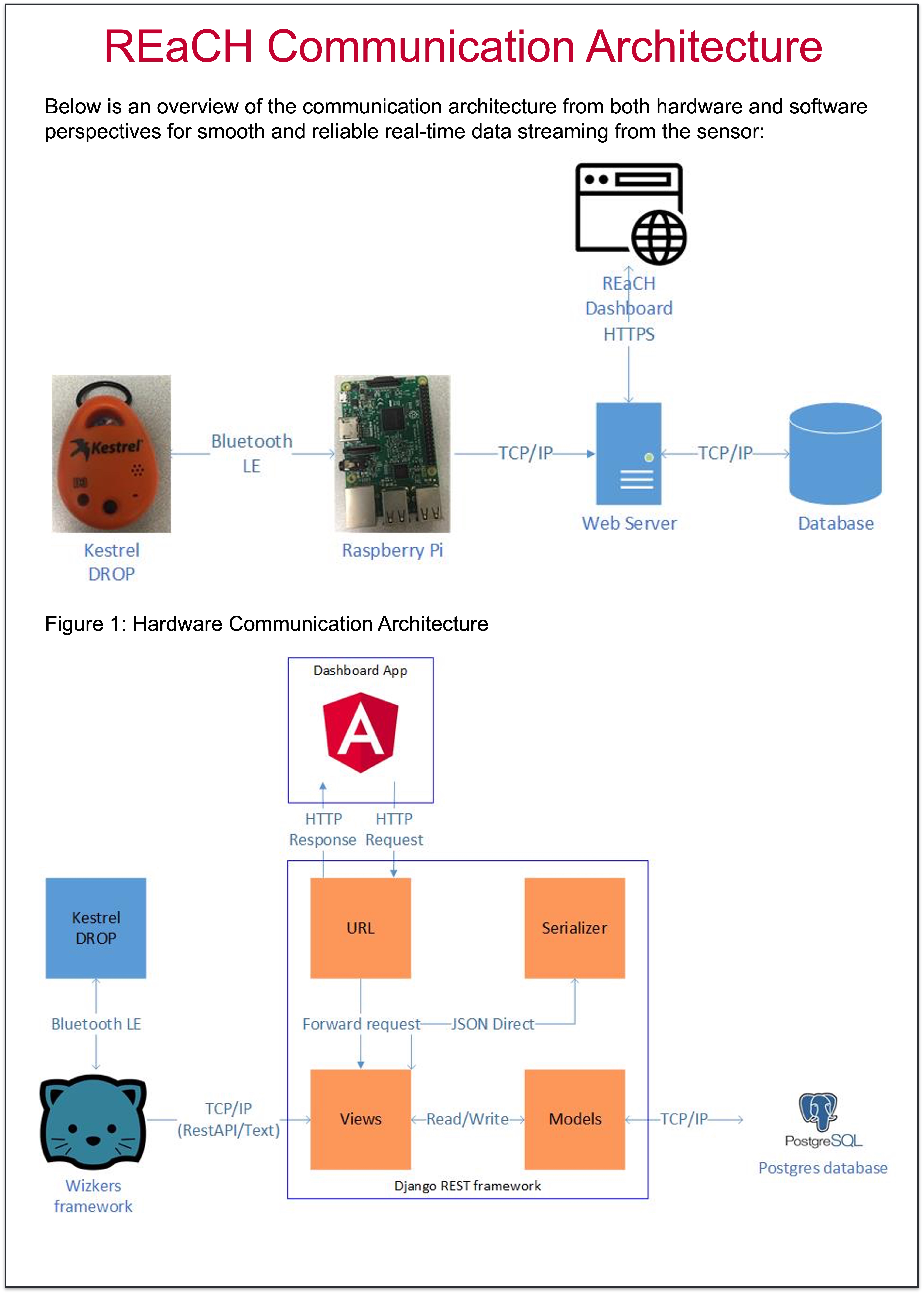
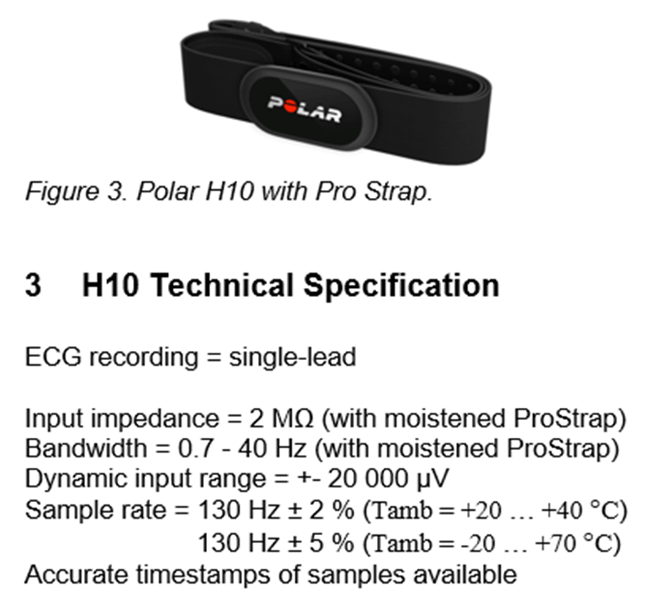
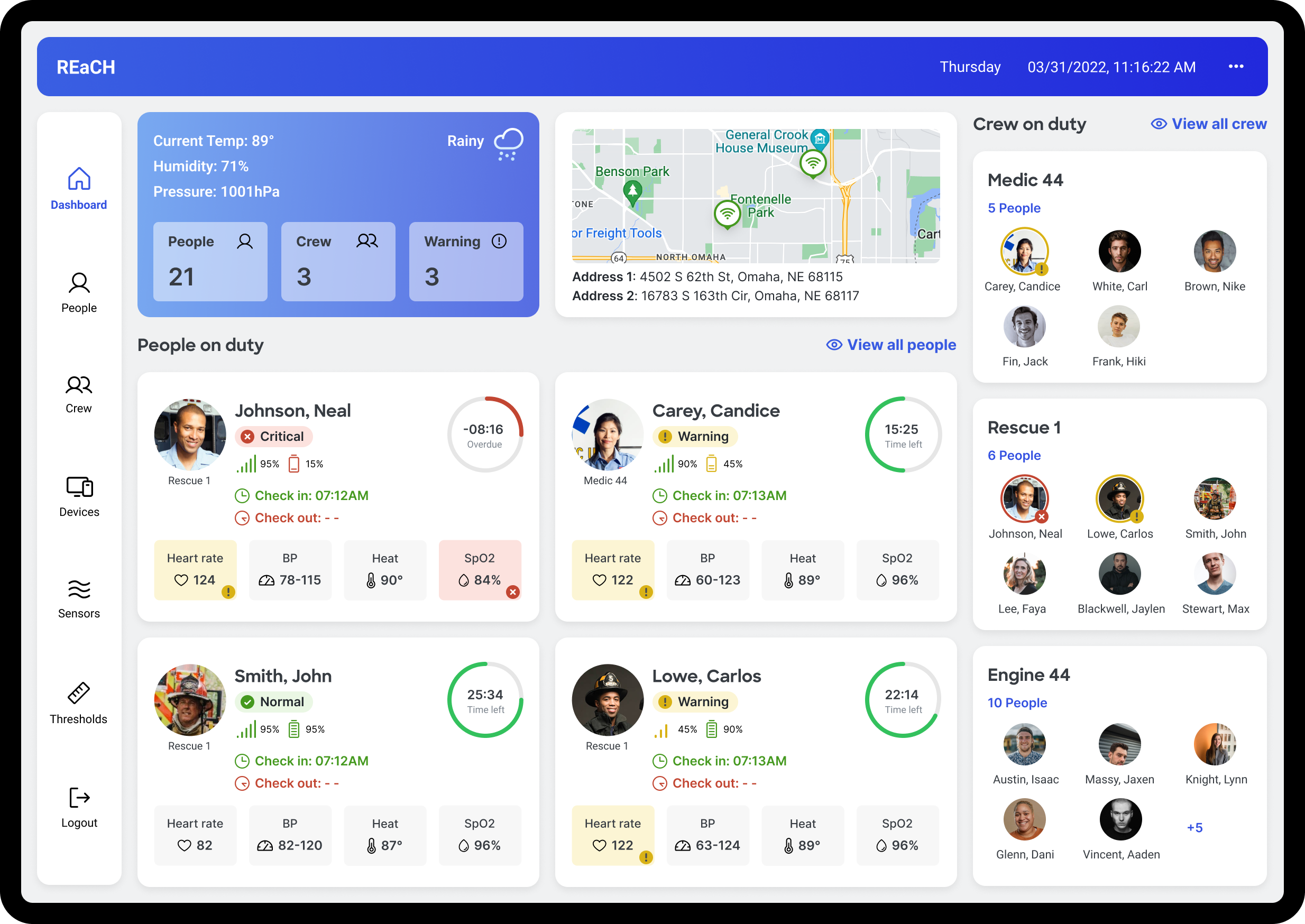
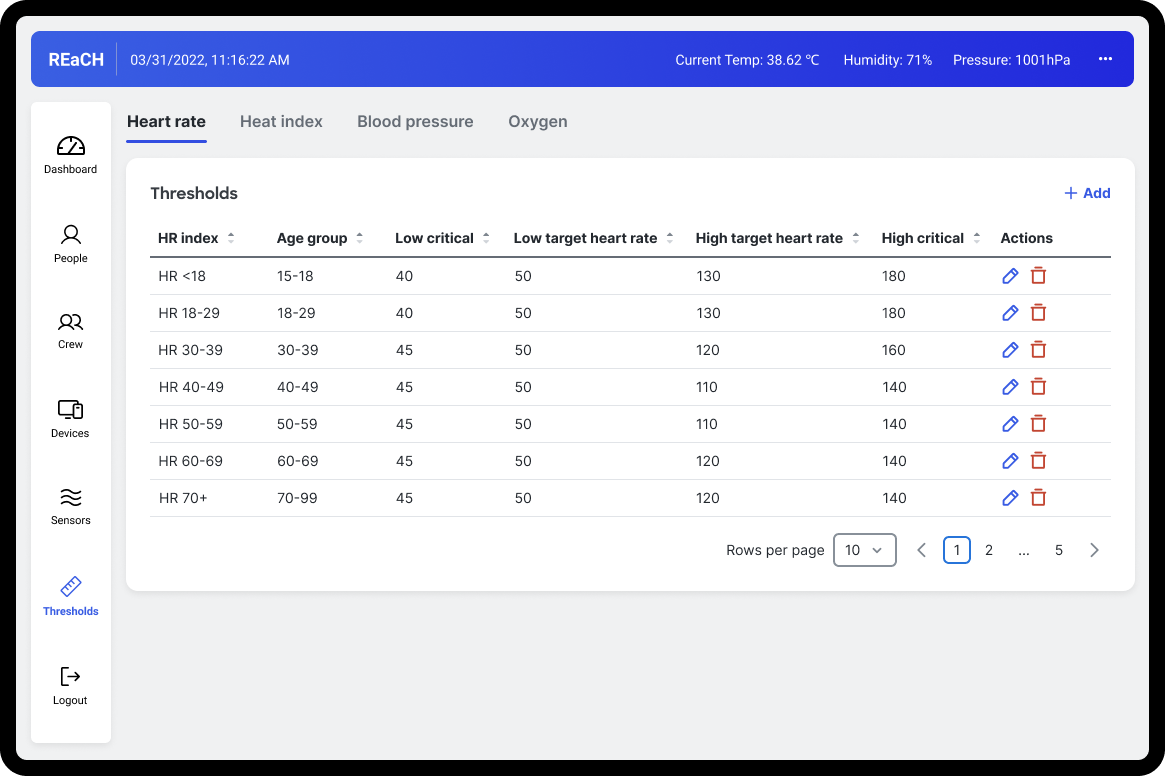
Refer Figure 4, 5, for Heart Rate Variability Statistics:Below you can see a 30-minute window that moves incrementally 1 minute, from a 24-hr ECG recording of a subject.
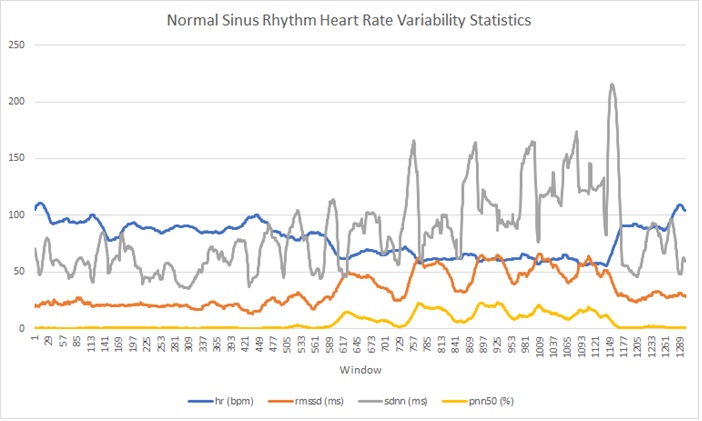
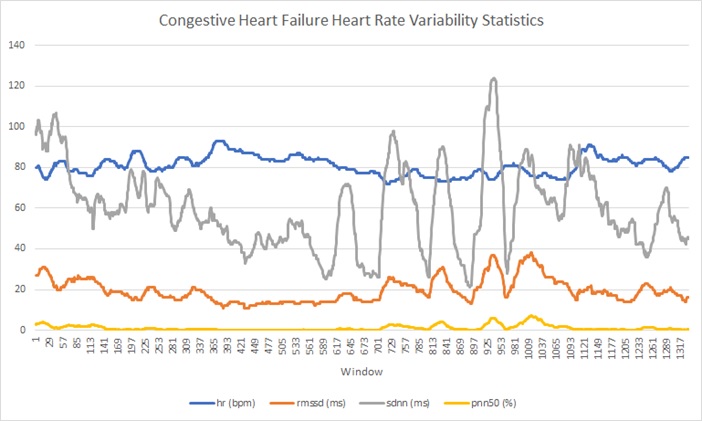
Product Execution
Phase 3—Product execution GTM strategy,
- Leveraged existing relationships through WOM recommendation from our existing customer/early adopter for this Product.
- Attended sponsored conferences for increasing product awareness.
- Prioritized high incident rate cities to go to market, due to limited budget as a small start up.
Metric and Measurement
North Star
The chosen north star metric for the product is "reduction in on-duty injuries" as it aligns directly with the product's purpose of improving firefighter safety.To measure this metric, a baseline of the number of injuries sustained by the City of Omaha fire department prior to implementing the product would be established, and injury rates would be tracked over time after the product is implemented.
Qualitative data from firefighters and supervisors would also be gathered to understand the impact of the product on injury rates and inform future development.
Comparison with other fire departments in the area that have not implemented the product would be done to control for external factors, such as changes in the incident number or severity of incidents.
Top 3 metrics
The three potential success metrics for the wearable sensor and dashboard solution for firefighters are:
- Reduction in on-duty injuries for first responder (this north start metric for sure, that the goal and purpose of the product, for sure )
- Faster response times
- Increased adoption rates by other fire departments based on the recommendation of the City of Omaha fire department.
Product success metrics to measure effectiveness
For the beta product that has been tested for workability but not yet implemented in real-world scenarios, three potential metrics for success are user feedback, accuracy and reliability, and cost-effectiveness. These metrics will be used to improve the product and ensure its effectiveness in addressing user needs.
- User feedback, we want to make sure that our users find the product useful and effective in addressing their needs and want to use the product. Considering this is a new concept, product on first responders that required to gather their health data. That's why user feedback is so important – we conducted surveys and interviews to gather feedback on the product's usefulness, ease of use, and effectiveness. This will help prioritize features for the next phase.
- Accuracy and reliability. We need to make sure that the data collected by the sensors is accurate and that the alerts are triggered appropriately. We compared the data collected by the sensors with data collected through other means and conducting tests to ensure that the alerts are triggered correctly.
- Cost-effectiveness will be evaluated by estimating potential savings and comparing with implementation and maintenance costs.
